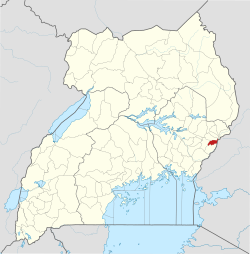Bududa District | |
|---|---|
 District location in Uganda | |
| Coordinates: 01°01′N34°20′E / 1.017°N 34.333°E | |
| Country | |
| Region | Eastern Uganda |
| Capital | Bududa |
| Area | |
| • Land | 250.8 km2 (96.8 sq mi) |
| Elevation | 1,800 m (5,900 ft) |
| Population (2014 Census) | |
• Total | 210,173 |
| • Density | 838/km2 (2,170/sq mi) |
| Time zone | UTC+3 (EAT) |
| Website | www |
Bududa District is a district in the Eastern Region of Uganda. Bududa is the chief town of the district.